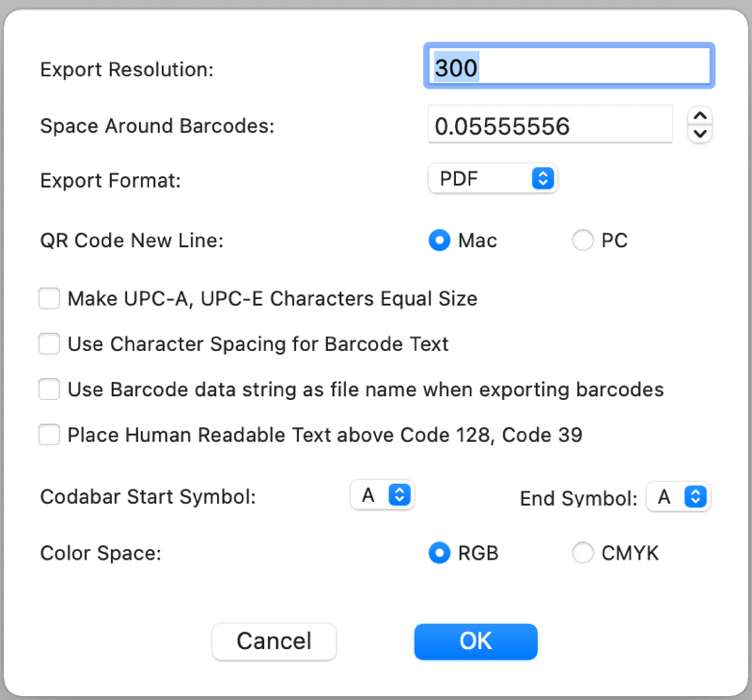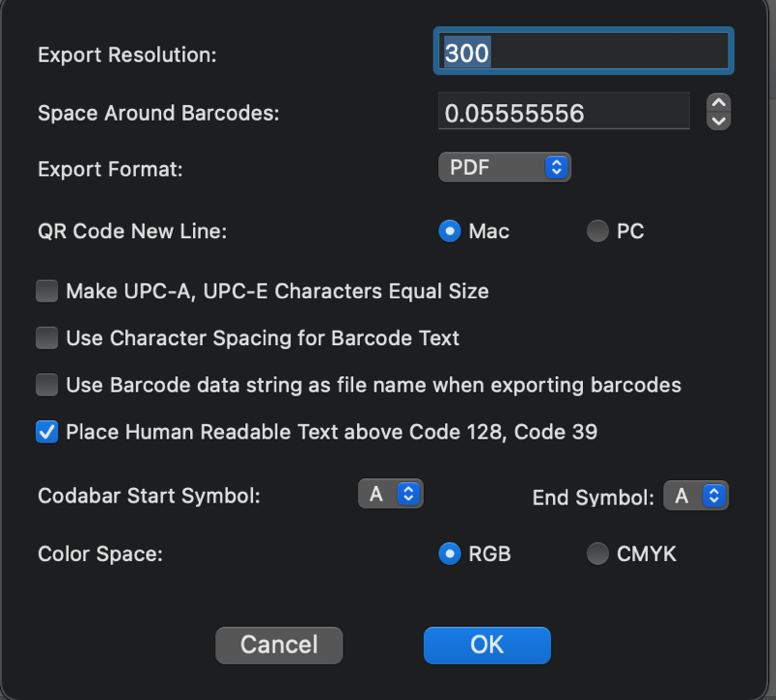Categorised lists of mac barcode software to produce barcodes related links, references, and specifications. Includes a search facility and an FAQ.Categorised lists of barcode related links, references, and specifications. Includes a search facility and an FAQ. The problem was, of course, that the card reading equipment of the day was bulky, utterly unwieldy, and hopelessly expensive. Even if the country had not been in the middle of the Great Depression, Flint's scheme would have been unrealistic for all but the most distant future. Still, it foreshadowed what was to come.
New York Times reported “Jerry Frankel, the president of the Susan Powter Corporation, says that “Stop the Insanity!” has spawned an industry” Speaking on first year revenues, “Frankel says he expects the company’s gross revenues for 1993 to reach $50 million.”, Advertising Age, July 4, 1994, reported “Stop The Insanity” infomercial project did in excess of $60m in its first year,. Pulitzer’s marketing positioning of Susan Powter as “the housewife who figured it out”,
Pulitzer’s company went down, even though it had in excess of $200M in contracts for its “Q’s” in notable publications and media,. However, the company could not bridge the gap between the horrible crashed markets and the time the contracts would mature. One of the more notable big deals, Pulitzer negotiated for his Scan Commerce and Scan-to-Connect Technology were:
During the follow up Season 3 of “Curse of Oak Island” St. Mary’s University in Halifax used simple test to date the “Oak Island Roman Sword” to be from approximately 1738, however critics called in a “fake bought on ebay”. Pulitzer published a scathing 200 page scientific report on the artifact and other comparable in retort to what he called “poor and unqualified testing” used by St. Mary’s University.

Companies may also use EAN-8 smart, intuitive bulk barcode maker software to encode RCN-8s (8-digit Restricted Circulation Numbers) used to identify own-brand products sold only in their stores.Companies may also use EAN-8 barcodes to encode RCN-8s (8-digit Restricted Circulation Numbers) used to identify own-brand products sold only in their stores. Definition: Bidirectional symbologies are common in most barcode variations including linear, 2D and 3D Barcodes. Bidirectional symbology allows a scanner to read the code either by moving from left to right or right to left.
The QR code has full (360 degrees) reading features. Each QR code has three finder patterns located in three corners of the QR code. A CCD reading device can detect and decode the position of the barcode, the size of the barcode and the size of the inclination angle.
2001 – TechDirt, Appliance Design and others reported, “Philips today unveiled a home grocery shopping device. It lets you scan in bar codes of groceries you’ve bought to build a regular “shopping list”. That list can then be sent to or downloaded by a grocery store for pickup or home delivery.”,
Business Insider wrote, “Interestingly, it seems the CueCat is worth more dead than alive. Once available for free, the device can now be found on sale at eBay for prices ranging from $5 to as much as $100.”

Codabar barcode generator for creating any number of individual, or sequential barcodes, are used by logistics and healthcare professionals, including U.S. blood banks, FedEx airbills, photo labs, libraries, etc.Codabar barcodes are used by logistics and healthcare professionals, including U.S. blood banks, FedEx airbills, photo labs, libraries, etc. The DOT COM crash of the early 2000’s saw many technology causalities alongside Pulitzer’s DigitalConvergence.
Lost Treasures You Can Find in Georgia: Follow the Clues and Find Your Fortunes! (Volume 2) ISBN-13: 978-1495950056
There are plenty of other barcode readers available for iPhone. These 15+ apps performed quite well for us.
Hiding markers in t-shirt logos it is possible to show movie-like special effects in real-time on the visitors' clothes, with potential for retail applications.

EAN-8 is encoded using the three EAN-13 character sets and also has a check digit that is calculated in the same manner as EAN-13. There is a limited number of EAN-8 create sequential barcodes and sequential text available in each country. So, they are issued only for products with insufficient space for an EAN-13 symbol.EAN-8 is encoded using the three EAN-13 character sets and also has a check digit that is calculated in the same manner as EAN-13. There is a limited number of EAN-8 barcodes available in each country. So, they are issued only for products with insufficient space for an EAN-13 symbol. In addition to being scalable, the Trillcode also stands out because it’s one of the few 2D barcodes that integrates the decoder into the phone application. This means that servers are not relied on to decode the barcode, freeing up data traffic and data fees. In addition, the Trillcode is an omni-directional barcode that embeds forms, making it easy to place orders and or generate feedback. Trillcode also allows for a lot of modifications – it’s easy to change colors, add a logo, or even an animation!
SectionsSEARCHSkip to contentSkip to site indexLog inToday’s PaperScan ArtistsAdvertisementContinue reading the main storySupported byContinue reading the main storyTalkScan ArtistsBy Alice RawsthornFeb. 23, 2010Question: What’s on the cover of almost every magazine, from Artforum to The National Enquirer? Clue: It’s also on every book, soda can, FedEx package and airline boarding pass. Bigger clue: Black stripes.Time’s up. Answer: The bar code — the white rectangle filled with vertical black stripes and a horizontal line of numbers that’s printed on the packaging of almost everything we buy. It has been ubiquitous for more than 20 years, so much so that we often fail to notice it. (Unless, of course, you’re one of the occultist conspiracy theorists who are convinced that it contains a secret Satanic symbol, but we’ll return to them later.)Familiar though it may be, the bar code is just now coming into its own. Because this is a fashion magazine, it doesn’t feel too skittish to note that black and white stripes will be very big this spring. (Think of Riccardo Tisci’s great monochrome jackets at Givenchy.) Or that you can commission beautiful bespoke bar codes from the Japanese design group Design Barcode (motto: “Big ideas are small”) in the shape of skyscrapers, houses, wind turbines, waterfalls or whatever else you fancy.But the real reason for the bar code’s renaissance is that it’s taken on a new role. Having been mostly useful to retailers and manufacturers, it can now help the rest of us shop a little more responsibly.The bar code dates back to the late 1940s when Bernard Silver, a graduate student at the Drexel Institute of Technology in Philadelphia, overheard a local retailer asking if it would be possible to invent a system of reading information about each product during checkout. He and a friend, Norman Joseph Woodland, devised a way of encoding data in concentric circles of differing widths, based on the Morse code that Woodland had learned as a Boy Scout. The width of the circles and of the spaces between them signified different pieces of information. Their design was patented in 1952, but they failed to invent a device to read it.By the early 1970s, when retailers were searching for an automated checkout system, Silver and Woodland’s patent had expired. Even so, the eventual system, I.B.M.’s Universal Product Code, was based on similar principles, except that the lines were vertical, not circular. On June 26, 1974, a pack of chewing gum became the first product to be sold using a bar code scanner at a supermarket in (cue Lorrie Moore) Troy, Ohio.Bar coding didn’t catch on as quickly as expected. Two years later, BusinessWeek ran an article entitled “The Supermarket Scanner That Failed.” It wasn’t until the early 1980s, when discount chains like Kmart introduced it — followed by other retailers here and abroad — that the tide turned. Retailers hoped to save money on the cost of putting stickers on each product but soon realized that the bar code was far more useful in tracking what they were selling and why. The rest of us, they argue, have benefited from (slightly) lower prices and a better chance of being able to buy what we want when we want it.Sounds reasonable, but not to everyone. Take those occultists, who’ve devoted countless Web sites to arguing that every bar code contains the numbers 666, which was identified in the Bible as the “mark of the beast” (a k a the Antichrist).Designers often dislike them too, not for suspected Satanism but because they’re obtrusive. It’s easy to spot which art directors are among them. They’re the ones whose magazine covers are marred by a bar code splodged in the corner.Other designers try their best to disguise them. “They took up quite a bit of real estate on CD covers,” sighed Stefan Sagmeister, who wraps the books he designs in a thin layer of cellophane so he can stick the bar code onto a sticker. (The book designer Irma Boom disagrees. “I love bar codes,” she said. “The bigger, the better. They make the dullest books look contemporary.”)So what is it that the bar code can suddenly offer the consumer? Well, if you want to see how a product — say, a bottle of shampoo or a box of muesli — scores in terms of its impact on health, society and the environment, you can text the bar code number to GoodGuide, a company that assesses those factors for thousands of products, or scan the stripes into your iPhone, and up pops the score. Devilishly clever, not least because a clean conscience may offer some consolation if you’re too far down the waiting list for that Givenchy jacket.AdvertisementContinue reading the main storySite IndexSite Information Navigation© 2021 The New York Times CompanyNYTCoContact UsAccessibilityWork with usAdvertiseT Brand StudioYour Ad ChoicesPrivacy PolicyTerms of ServiceTerms of SaleSite MapCanadaInternationalHelpSubscriptions
Bakodo: this app scans all types of barcodes, allowing you to open URLs and perform searches. Helps you get detailed product information to make better decisions.
This professional biography has been assembled exclusively using national third party cited references per Wikipedia Standards. The over 700 cited 3rd party sources utilized to electronically assemble this professional biography include: Wikipedia, Wall Street Journal, New York Times, Academia.edu, Security & Exchange Commission, NASDAQ, Patent Genius, IP Watchdog, History.com, CNET, AdAge, Broadcasting and Cable Magazine, Forbes, Newsweek, Business Insider, Amazon, Dallas Morning News, Bloomberg News, The Guardian, Investopedia, Washington Post, PC World, Yahoo News, Yahoo Finance, Tech Times Magazine, USA Today, Poynter.org, Fortune Magazine, Business Journal, LA Times, Harvard Business Journal, Clickz, Geek.com, Wired Magazine, BrightHub, Mashable, Gizmodo, CalTech, HighBeam, NY Post, Silicon Investor, Verison.com, Media Post, Smithsonian, CW Honors, WebCitation, Macworld, Google Books, United States Patent and Trademark Office, Google Patents, RPX Corp, Apple.com, The Verge, PC World, The Telegraph UK, Variety, New Yorker Magazine, People Magazine, AOL, New Yorker Magazine, Chronicle Herald, ZDNet, Cato.org, Daily Mail UK, The Boston Standard, Free Library and other known media outlets.
